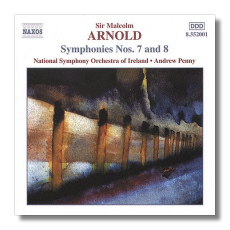
The Internet's Premier Classical Music Source
Related Links
- Arnold Reviews
- Latest Reviews
- More Reviews
-
By Composer
-
Collections
DVD & Blu-ray
Books
Concert Reviews
Articles/Interviews
Software
Audio
Search Amazon
Recommended Links
Site News
 CD Review
CD Review
Malcolm Arnold

Late Symphonies
- Symphony #7, Op. 113
- Symphony #8, Op. 124
National Symphony Orchestra of Ireland/Andrew Penny
Naxos 8.552001


- Symphony #7, Op. 113
- Symphony #8, Op. 124
- Symphony #9, Op. 128
- Oboe Concerto, Op. 39
Jennifer Galloway, Oboe
BBC Philharmonic Orchestra/Rumon Gamba
Chandos 9967 (two-fer)
If your only experience with Arnold is the film music and Four Dances, brace yourself. The words that appear most often in my notes are, "He is like an English Martinů." I might also add that if Shostakovich used the quartet to express his innermost feelings, Arnold uses the symphony. Every work is wrought with emotion, at least in the good recordings.
The 7th Symphony is, in some way, about his children. The third movement is about his "tragically autistic" son Edward. Other than that, there is no discussion about any of the other two in any of the notes I read. None of the notes really explain what is meant by a reference to the children and Arnold's own comments, quoted in the notes, are no less enigmatic. I have no idea how you could write music that captures the essence of someone, even though Elgar did. As I listened to these two recordings, however, I felt I was listening to three distinct personalities. In the first movement I realized that what we have here is feedback between the father and the daughter, Katherine. We are learning as much about the father as the daughter. In effect we are seeing the emotions of both and each of them. This is feedback and each following movement draws out a different personality. The one about Edward opens with an angry three beat progression from the percussion. It ends with the same three beats but now they are on cowbells. This time, however, they are more triumphant. The cowbells are a weird experience.
The symphony's first movement, Katherine, charge into things is intense, then the weirdness really sets in when things segue into some Twilight Zone meditations. The second theme, brought out after the segue, moves in different patterns throughout the concept. There is a philosophy here. Then, a sudden, a ragtime variation jumps out of nowhere, but is now mocking the theme. Now, Penny's recording of this movement gives it a chamber-like quality to the playing. There are details that abound and float on the surface; there is inner detail with air around the music. The Chandos recording is very, very different. For starters he takes over three minutes off this movement. Yes, it is fast and yes it is more intense. The jazz sequence is more angular; even more surrealistic than the Naxos recording. The middle movement, about Robert, is the most peaceful. Even here, however, shadows lurk. The one about Edward opens with an angry three beat progression from the percussion. It ends with the same three but now they are on cowbells. This time, however, they are more triumphant. The cowbells are a weird experience.
After several attempts at describing he differences in the two recordings I have reached the following conclusions. The sound stage from Naxos is starker, the Gamba recording is warmer and more "orchestral". It is still dark, however, and, as mentioned, the faster playing imbues the symphony with a manic quality. Both are surreal. In order to claim to understand this work of art, you really must have both recordings. Tell your spouse or "live-in" that you NEED both.
Don't let the opening fool you, the 8th is a much more pastoral symphony. One writer said it was an "envoi" to Arnold's film music. (Now, you go look up that word like I did!) Thanks to the tip, I did feel that the composer took the Irish reference in the last movement of the 7th and extended it to the next symphony. To be honest, however, the Eighth just doesn't cohere for me the way its predecessor does. Here, again, the difference between the two recordings is due, to some extent, by the size of the orchestras and recording. Perry is more like a chamber orchestra and stark. Gamba's recording is more cinematic and orchestral. If it doesn't hold my attention as strongly this is still a fascinating piece of music.
You NEED both.
Post Script: I will report on the 9th in another review.
Copyright © 2002, Robert Stumpf II




















